We’ve been helping innovation managers for over 15 years, consulting on and managing innovation projects inside enterprises, government agencies, and academic institutions. Here’s a summary of the process we used during this time to manage innovation projects, which involves reducing innovation risk and uncertainty in ideas until they justify full implementation funding:
Assemble a discovery team: Reducing the inherent innovation uncertainty that is part of high-potential ideas requires specific expertise. So, the first step entails finding a skilled team to do some discovery work and determine whether they can make the idea work.
Map out the biggest unknowns to the idea’s success: The discovery team’s first task is to identify what would have to be true for the idea to work. These are known as assumptions or educated guesses. For most ideas, the biggest uncertainties would be users not wanting it or the company not being able to build it.
Run experiments to test assumptions: Discovery teams should design and run experiments to test each assumption, prioritizing those with the highest uncertainty. For example, if the biggest uncertainty is a lack of customer demand, the discovery team could create a landing page explaining the product’s benefits, run ads, and see how many people join the waiting list or click a “buy now” button.
Monitor uncertainty indicators: Discovery teams should use uncertainty indicators. If the uncertainty is successfully reduced, teams test the next assumption. If they were unable to reduce uncertainty, but the knowledge gained means there’s another way to make the idea work, the team can pivot. If the team can’t reduce uncertainty to an acceptable level, the idea is terminated.
Repeat the process: Discovery teams continue validating assumptions and reducing uncertainty until it becomes a sound decision to spend significant resources on implementation.
We put together this article to help companies manage innovation uncertainty at scale and deliver successful innovations that generate real returns with minimal resource waste.
InnovationCast is an innovation management platform that has helped companies such as DHL, Visa, and Vodafone surface ideas and reduce uncertainty before implementation. If you’d like to see how InnovationCast can assist your team, book a 25-minute demo.
Author’s Note: Use Metered Funding to Reduce Innovation Risk Uncertainty
Before discussing the risk management process we use, we’d like to cover one of the most critical factors determining the success of the discovery team’s experiments: the funding approach used by top management.
In most companies we’ve worked with, we’ve seen that top management funds entire innovation projects from the outset. This introduces two key challenges:
It wastes resources: When teams know they have a budget for the entire project, they design more resource-intensive experiments and stop testing things as cheaply and quickly as possible. For example, they may develop the whole UI instead of showing mockups to potential customers. This limits the number of ideas companies can pursue.
Companies can’t reassign resources based on the success of experiments: Funding every experiment upfront also makes it difficult for companies to move resources away from failing projects to more successful ones. Resources become stuck in 'zombie projects' — initiatives that consume resources but show no potential.
We recommend that companies refrain from funding entire projects upfront; instead, consider a Metered Funding approach.
Metered Funding is an innovation risk management approach that involves funding one experiment at a time and only unlocking further funding if the experiment successfully validates the highest-uncertainty assumption.
If innovation risk and uncertainty aren’t reduced, top management cuts funding and redirects it to projects where teams can reduce uncertainty.
Note: Metered Funding helps persuade top management to invest in innovation. Instead of requesting full upfront funding, teams ask for less funding and validate only the highest-uncertainty assumptions. As uncertainty decreases, leadership is more likely to release additional funding.
Step 1: Create a Validation Team Responsible for Reducing Associated Risk and Uncertainty
Once companies have collected ideas, evaluated them, and landed on a shortlist of high-potential ones that fit their strategic goals, they place a discovery team in charge of each idea and task them with reducing uncertainty.
The standard composition of a discovery team features an engineer, a designer, and a marketer.
These competencies provide a solid foundation for running experiments and gathering knowledge about an idea. The engineer is responsible for developing MVPs, the designer ensures that the UI is usable, and the marketer runs ads, creates messaging, and tries to understand if there’s demand.
Top management provides the discovery team with time and a suitable budget to run experiments, systematically reducing risk until it aligns with the company’s risk tolerance.
Read more: How to Encourage Innovation in the Workplace | InnovationCast
Step 2: Use Innovation Management Software to Help Guide Your Team Through Managing Uncertainty
The number one reason companies struggle to manage innovation projects at scale is that they provide the discovery team with little guidance on how to manage and reduce uncertainty in ideas.
The discovery team might include an engineer, designer, and marketer, but they rarely have a background in innovation and uncertainty management. They likely don’t know how to map assumptions, land on minimum success criteria, design and run experiments, monitor performance metrics, know when and how to pivot based on results, understand risk assessment, etc.
Innovation project management differs from traditional project management, where all the tasks and deadlines are clearly defined from the outset, and everyone knows what to do and how to do it. In innovation management projects, there is no certainty about the outcomes or the way to get there.
Managing innovation uncertainty takes time and is non-linear, iterative, and sometimes chaotic. Expecting three employees with no innovation management experience to manage this risk management process sets the initiative up for failure. Stakeholders see little to no progress and eventually pull funding.
Organizations with the most productive innovation uncertainty management processes use dedicated innovation management software to guide employees in managing innovation uncertainty.
High-quality innovation management software should contain the workflows that walk discovery teams through the entire process, from assumption mapping to experimentation, decision-making, and more. This reduces guesswork and increases the success rate of innovation projects.
Note: Many companies will ask innovation managers to lead innovation projects and manage the innovation uncertainty. This may work fine for companies managing a smaller number of innovations, but for larger companies, it’s unrealistic to expect a handful of innovation managers to oversee all projects.
Instead, high-quality innovation management software offers this guidance at scale without innovation managers having to oversee each assumption mapping session and manage experimentation themselves.
How InnovationCast Guides Discovery Teams Through Managing Innovation Uncertainty
We designed our innovation management platform, InnovationCast, with comprehensive and customizable validation workflows that act as a guided playbook, walking teams through the process of managing and reducing uncertainty.
Our workflows guide you through mapping assumptions, prioritizing them, designing and running lean experiments, selecting the right people, evaluating data, balancing portfolio uncertainty, and more. This includes assumption and experiment templates, examples of validated similar ideas, and uncertainty mapping boards.

It’s important to consider that different ideas need different steps to reduce uncertainty. Unfortunately, most software falls short — they customize your workflow during onboarding, but you’re stuck with just one.
With InnovationCast, you get tailored workflows for different idea types: business models, new products, technology, and innovation processes.
We work with you to understand your innovation strategy, priorities, and types of ideas, tailoring workflows accordingly. You can customize these workflows at any time.
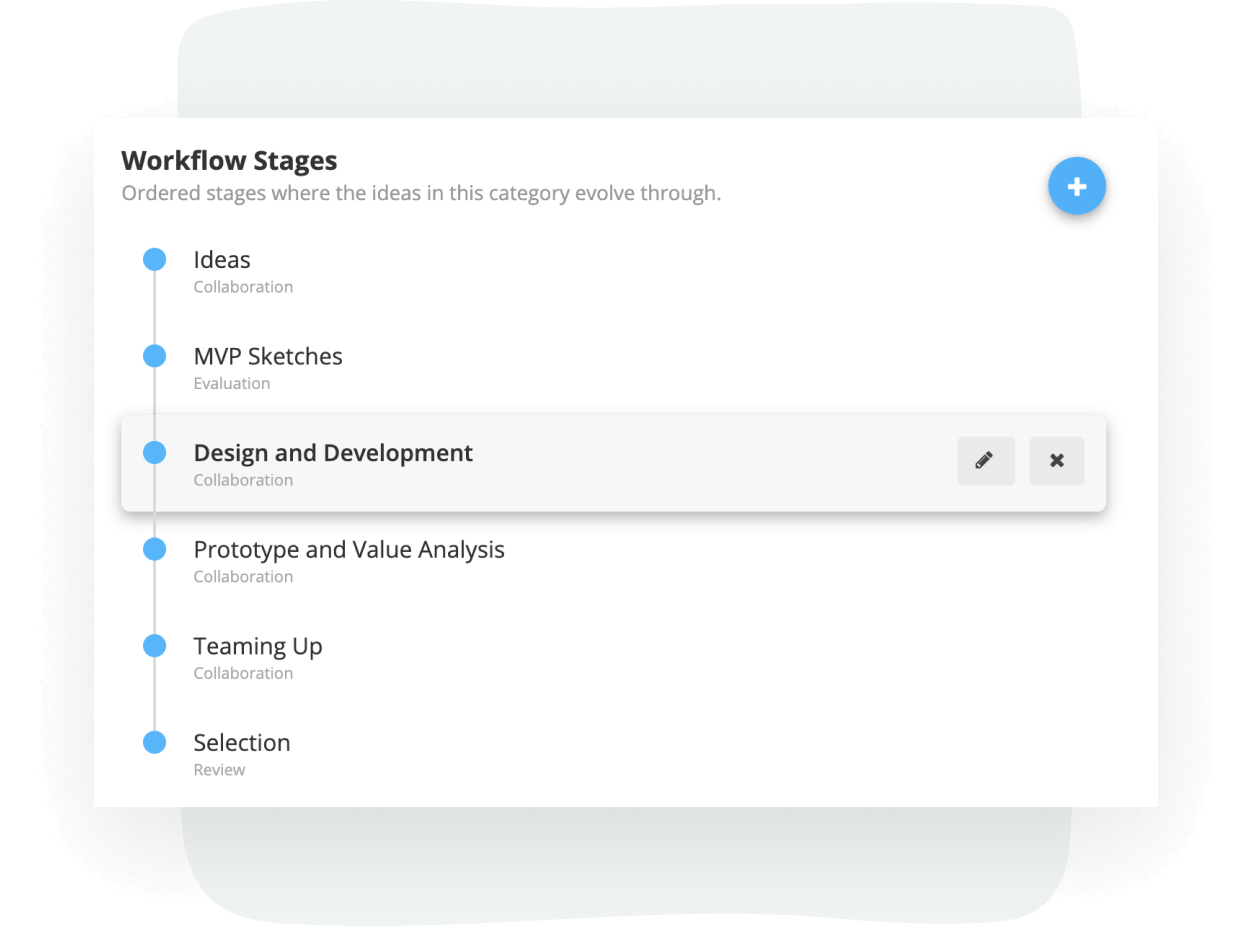
Reports, photos, videos, quotes, metrics, and test results are tied directly to the idea, and its hypotheses are stored within InnovationCast. Stakeholders, managers, and employees can see which uncertainties are still open and which have been confirmed. This is fundamental to securing future funding.
Step 3: Identify Potential Risks and Uncertainties to Project Success
A common issue with newly formed, inexperienced, and well-funded discovery teams is that they often run experiments in a haphazard, almost random manner. It’s typical for discovery teams to spend a few minutes discussing an idea before settling on experiments they believe — or have heard — work well.
This careless approach to experimentation usually leads discovery teams to first test aspects of the idea that don’t pose much uncertainty and ignore the biggest uncertainty factors. Then, after significant resource expenditure, teams finally start testing the biggest uncertainties and learn that the idea isn’t practical. This leads to unnecessary resource waste.
Instead, we recommend focusing resources in the early stage of the innovation project on the highest uncertainty factors. An effective way to do this is through assumption mapping.
Assumptions are statements that must hold true for an idea to be successful. By mapping assumptions, discovery teams can identify the biggest uncertainties to an idea’s success. They can then focus their experiments on those uncertainties first.
For instance:
We believe people will pay for this (or adopt it).
We believe the problem we’re solving is real and worth solving.
We believe the solution is technically feasible to build.
We believe there are no significant legal, compliance, or cybersecurity barriers.
The method we recommend for mapping assumptions is to first define the idea’s problem statement: what problem is the idea aiming to solve?
For instance, busy professionals seek high-quality coffee that’s both fast and affordable, yet existing machines are often too slow, costly, or compromise on flavor. There's a need for an inexpensive coffee maker that quickly delivers café-quality brews.
Once discovery teams have articulated their problem statement, they should ask what factors need to be true for the idea to tick all the boxes in the problem statement.
For example:
We believe busy professionals want high-quality coffee at home.
We believe they value speed and convenience in their morning routine.
We believe affordability is a major factor in their purchasing decision.
We believe current coffee machines fail to balance quality, speed, and price.
We believe we can build a high-quality coffee machine at an affordable price.
We believe users are dissatisfied enough with existing options to consider switching.
From here, teams should structure these assumptions from highest to lowest uncertainty. They can do this by thinking of what will kill the project if it is untrue. This is usually related to whether customers want the innovation and whether the company can build it.
Side note: A common mistake discovery teams make when mapping assumptions is excluding stakeholders from the process. Without shared agreement on key assumptions, stakeholders may withhold funding — even if all assumptions are validated — because they still perceive high uncertainty. Involving stakeholders early ensures alignment and increases the likelihood of funding if assumptions are proven.
How InnovationCast Guides Teams Through Assumption Mapping
When innovation managers establish discovery teams, InnovationCast emails team members, notifying them that their expertise is needed.
Upon signing into their InnovationCast dashboard, team members can see which ideas they own and any information that the idea author added.
Based on the nature of the idea, InnovationCast provides workflows guiding teams through the assumption mapping process. We use tools such as uncertainty mapping boards, assumption templates, and validation canvases. We also provide resources on how other teams have tested similar ideas.
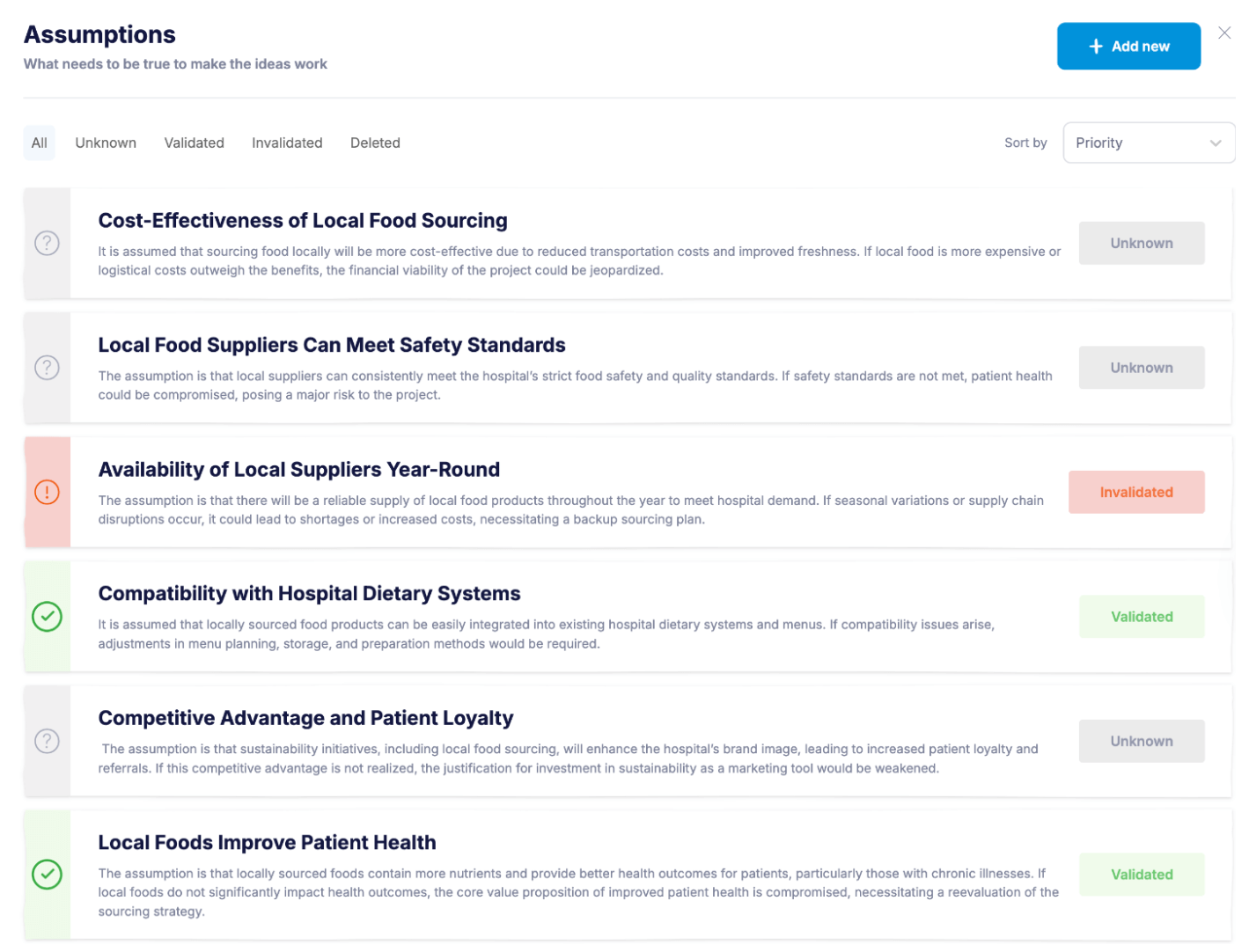
We set up and configure these workflows during onboarding and after learning about your innovation strategy, types of ideas needed, uncertainty appetite, and existing processes.
Through this guidance, companies ensure that discovery teams are strategically testing uncertainties and not running experiments at random.
Step 4: Run Experiments to Validate Assumptions and Reduce Uncertainty
After teams have identified the key uncertainties that could thwart an idea, they should run experiments to test the highest uncertainty assumptions first. Through strategic experimentation, discovery teams reduce uncertainty by learning which assumptions are accurate, which aren’t, and where they can pivot to make the idea work.
These are some go-to experiments we use ourselves and often see with clients.
The fake door test: Create a landing page, button, or sign-up option for a feature or product that doesn’t exist yet to test genuine interest.
Customer Interviews: Speak directly with potential users to validate problem relevance and customer experience.
A/B testing: Compare two versions of messaging, design, or offers to see which resonates more with users.
Wizard of Oz prototype: Simulate a working product manually behind the scenes to validate how people would interact with it.
Pilot program or soft launch: Release an MVP to a limited group of users to gather feedback.
After each innovation initiative, discovery teams, innovation managers, and top management meet to review the knowledge gained and agree on whether the assumption is valid. If the assumption is valid — say the discovery team was able to get a substantial number of people to join the waiting list — they launch the following experiment.
If the assumption is invalid, companies can do two things: they can pivot, tweaking the assumption to make the idea work. For example, customers didn’t want to subscribe monthly but were open to paying a one-time fee. If it’s not possible to pivot, they should discontinue the idea.
Read more: Idea Validation: A Guide to Affordably Testing Ideas
InnovationCast Workflows Show Discovery Teams How to Design and Run Experiments
With InnovationCast workflows, discovery teams access guidance such as experiment templates, evidence logs, learning dashboards, and assumption trackers — among other tools and resources that help them decide which experiments to run based on the nature of the idea and the level of uncertainty involved.
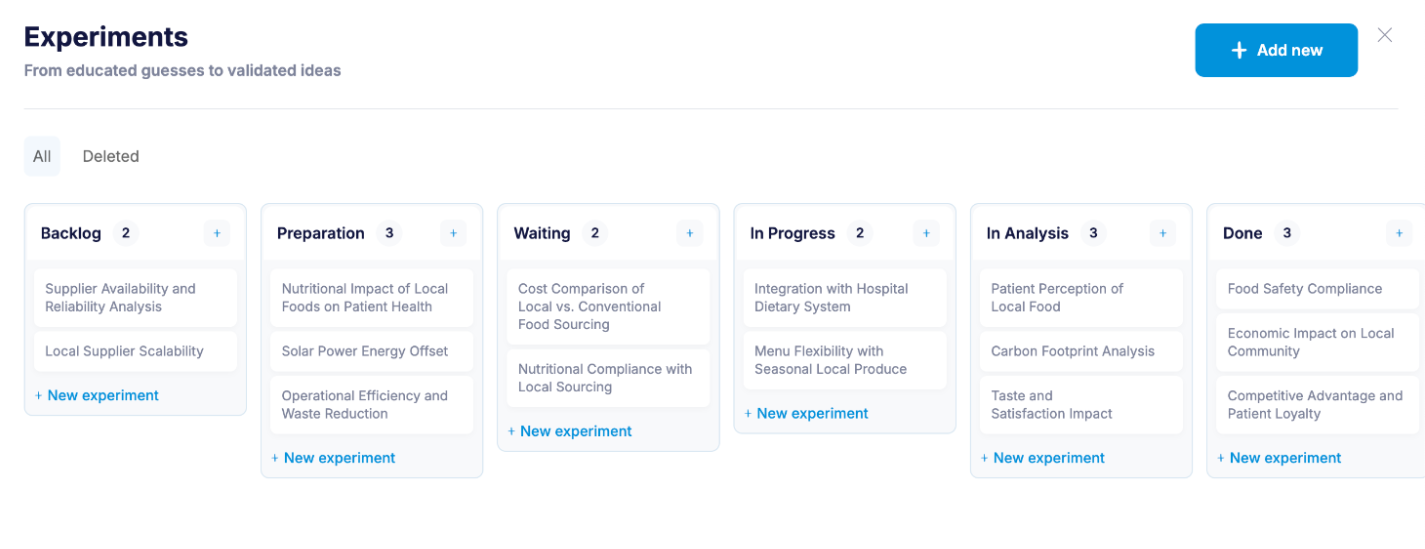
We customize these workflows and risk management strategies based on what we learned about your strategic goals during onboarding.
As teams run experiments, InnovationCast connects with their data analytics tool to automatically pull all knowledge into the reporting dashboard, where top management and other relevant stakeholders can visualize their learnings and make more informed decisions (more on this below).
Beyond our software, we are also your consulting partner, answering all your questions, helping troubleshoot projects, and guiding discovery teams on the next steps.
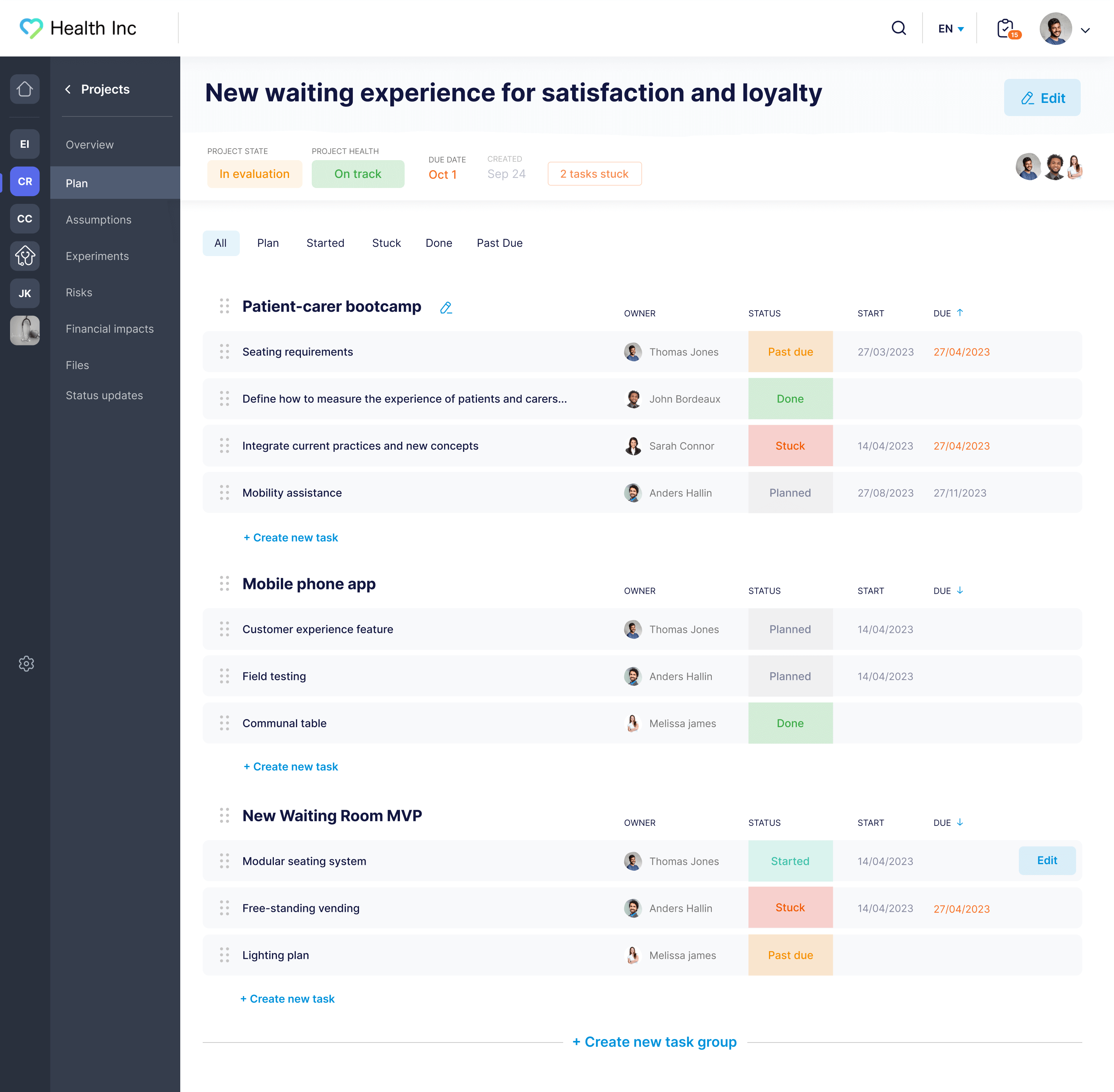
Step 5: Monitor uncertainty and Key Performance Indicators and Communicate Those Learnings to Top Management
The main reason many successful discovery teams (i.e., those that validate all assumptions) still struggle to secure funding for implementation is that the results of their experiments aren’t centralized in a place where they can be easily accessible to stakeholders and sponsors.
In most companies, discovery teams work with their preferred tools to track and monitor experimentation results; there isn’t a single location where stakeholders can log in and comprehend the outcomes of innovation projects across the organization. Consequently, top management thinks innovation isn’t delivering business growth and cut innovation funding.
Instead, we recommend utilizing a centralized platform where the results of experiments run across the entire company can be viewed and easily understood. Bringing insights together helps leadership stay on the same page and shows them that teams aren’t just spinning their wheels.
InnovationCast Offers a Reporting Dashboard Where Stakeholders Can See the Outcomes of Innovation Efforts
With InnovationCast’s reporting dashboard and portfolio manager, stakeholders and top management can track which innovation projects are being pursued, the budget allocated to each, the assumptions being tested, and the progress made toward validating those assumptions.
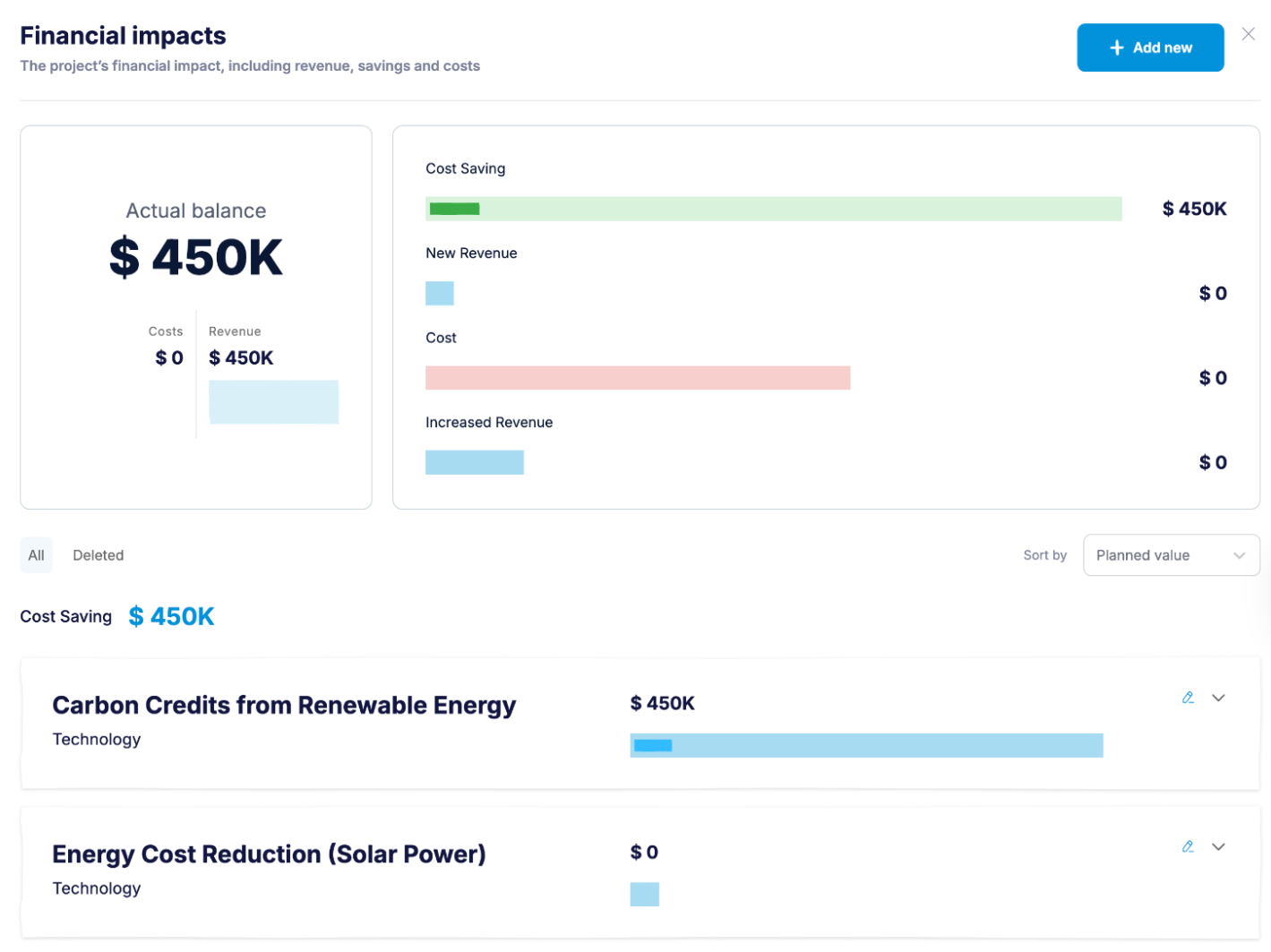
This way, decision-makers can visualize the value that innovation is generating on the organizational level and redirect resources based on which projects show the most promise.
For example, if a discovery team has validated a new product idea, stakeholders can log into InnovationCast, see how many people joined the waiting list, and watch snippets of interviews with prospects. Then, they can be confident that there’s user demand and greenlight further funding.
Step 6: Continue Validating Assumptions until the Idea Justifies Further Resources
Discovery teams should use the innovation process discussed above to test each assumption.
Once top management reviews the discovery team’s findings and issues more funding, they continue testing assumptions until uncertainty is reduced to an acceptable level, one that aligns with the company’s risk appetite. If they run into assumptions that aren’t valid, the idea is abandoned.
For most ideas, implementation is the responsibility of the project management office (PMO) and not the discovery team or innovation department. The PMO conducts traditional project management by defining project scopes, setting timelines, building partnerships with suppliers, allocating resources, and tracking profitability.
However, for revolutionary ideas that hold a lot of uncertainty even after all assumptions are validated, it’s essential for the discovery team, innovation department, and PMO to work together during implementation (and even after the product has been launched) because there’s still a lot of learning and discovery that needs to be done.
For example, when launching a new technology, such as the first smartphone or self-driving car, the discovery team may have validated that consumer demand and the technology needed for production exist. However, upon launch, they still need to continue addressing risks related to factors such as whether the first model works as intended, what improvements are necessary based on real-world feedback, how users interact with the product, and whether the solution can scale effectively.
Manage Innovation Uncertainty at Scale with InnovationCast
Book a quick InnovationCast demo to see how we can help you manage innovation uncertainty on an organizational level.
Related reads:

